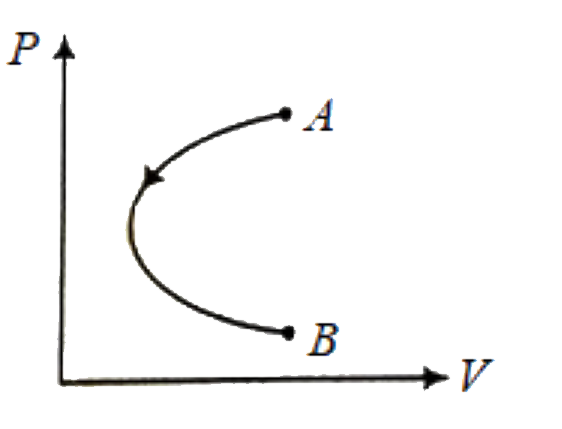Can we use Boyle's law to calculate the volume of a real gas from its initial state to final state during adiabatic expansion?
To determine whether we can use Boyle's law to calculate the volume of a real gas during adiabatic expansion, we need to follow these steps:
Step 1: Understand Boyle's Law
Boyle's Law states that for a given mass of gas at constant temperature, the product of pressure (P) and volume (V) is constant. Mathematically, it can be expressed as:
PV=k
where k is a constant.
Step 2: Identify the Conditions of Adiabatic Expansion
In adiabatic expansion, there is no heat exchange with the surroundings. The process involves changes in both pressure and volume, and importantly, the temperature of the gas decreases during this process.
Step 3: Recognize the Role of Temperature
Boyle's Law applies only when the temperature is constant. In adiabatic expansion, the temperature is not constant; it decreases as the gas expands. This means that the conditions required for Boyle's Law to hold true are not met.
Step 4: Consider the Behavior of Real Gases
Real gases do not behave ideally, especially under conditions of high pressure or low temperature. The interactions between gas molecules (such as attractive forces) must be considered. In adiabatic processes, these interactions can significantly affect the gas's behavior, further complicating the use of Boyle's Law.
Step 5: Conclusion
Since Boyle's Law requires constant temperature and the adiabatic expansion of a real gas involves a change in temperature, we conclude that:
No, we cannot use Boyle's law to calculate the volume of a real gas from its initial state to final state during adiabatic expansion.
---
Boyle's Law states that for a given mass of gas at constant temperature, the product of pressure (P) and volume (V) is constant. Mathematically, it can be expressed as:
PV=k
where k is a constant.
In adiabatic expansion, there is no heat exchange with the surroundings. The process involves changes in both pressure and volume, and importantly, the temperature of the gas decreases during this process.
Boyle's Law applies only when the temperature is constant. In adiabatic expansion, the temperature is not constant; it decreases as the gas expands. This means that the conditions required for Boyle's Law to hold true are not met.
Real gases do not behave ideally, especially under conditions of high pressure or low temperature. The interactions between gas molecules (such as attractive forces) must be considered. In adiabatic processes, these interactions can significantly affect the gas's behavior, further complicating the use of Boyle's Law.
Since Boyle's Law requires constant temperature and the adiabatic expansion of a real gas involves a change in temperature, we conclude that:
No, we cannot use Boyle's law to calculate the volume of a real gas from its initial state to final state during adiabatic expansion.
Topper's Solved these Questions
- STATES OF MATTERBOOK - CENGAGE CHEMISTRY ENGLISHCHAPTER - STATES OF MATTEREXERCISE - Exercises (Fill In The Blanks)
25 Videos
- STATES OF MATTERBOOK - CENGAGE CHEMISTRY ENGLISHCHAPTER - STATES OF MATTEREXERCISE - Exercises (Ture False)
25 Videos
- STATES OF MATTERBOOK - CENGAGE CHEMISTRY ENGLISHCHAPTER - STATES OF MATTEREXERCISE - Concept Application 5.3
1 Videos
- SOME BASIC CONCEPTS AND MOLE CONCEPTBOOK - CENGAGE CHEMISTRY ENGLISHCHAPTER - SOME BASIC CONCEPTS AND MOLE CONCEPTEXERCISE - Archives Subjective
11 Videos
- STOICHIOMETRYBOOK - CENGAGE CHEMISTRY ENGLISHCHAPTER - STOICHIOMETRYEXERCISE - Archives Subjective
33 Videos
Similar Questions
When a sample of ideal gas is changed from an initial state to a final state, various curves can be plotted for the process like P-V curve, V-T curve,P-T curve etc.
For example, P-V curve for a fixed amount of an ideal gas at constant temperature is a rectangular hyperbola, V-T curve for a fixed amount of an ideal gas at constant volume is again a straight line. However, the shapes may vary if the constant parameters are also changed.
Now, answer the following questions :
Two moles of an ideal gas is changed from its initial state (16 atm, 6L) to final state (4 atm, 15L) in such a way that this change can be represented by a straight line in P-V curve.The maximum temperature attained by the gas during the above change is :(Take : R=112LatmK−1mol−1)
View SolutionA diatomic gas is used in car not heat engine having efficiency 80% . Find the ratio of initial volume to final volume of gas during adiabatic expansion.
View Solution
Knowledge Check
An ideal gas undergoes isothermal process from some initial state i to final state f. Choose the correct alternatives.
A1.dU=dQB2. dU=-dWC3. dU=0D4. dU=dW
An idel gas undrgoes isothermal process from some initial state i to final state f. Choose the correct alternatives.
View SolutionAssertion:- During adiabatic expansion of an ideal gas, temperature falls but entropy remains constant.
Reason:- During adiabatic expansion, work is done by the gas using a part of internal energy and no heat exchange teakes place the system and the surrounding.
View SolutionDefine an adiabatic process and state essential conditions for such a process to take place. Write its process equations in terms of , and . Show analytically that work done by one mole of an ideal gas during adiabatic expansion from temperature T1 to T2 is given by =R(T1−t2)1−λ.
View SolutionDraw a graph to show the deviation of real gas from Boyle's law.
View SolutionStatement -1: The magnitude of the work involved in an isothermal expansion is greater than that involved in an adiabatic expansion.
Statement -2: P-v curve (P on y -axis and V on X-axis) decrease more rapidly for reversible adiabatic expansion compared to reversible isothermal expansion starting from same initial state.
View SolutionState Boyle's law in terms of pressure and density of a gas.
View SolutionP - V diagram of an ideal gas is shown. The gas undergoes from initial state A to final state B such that initial and final volumes are same. Select the correct alternative for given process AB.

View Solution
